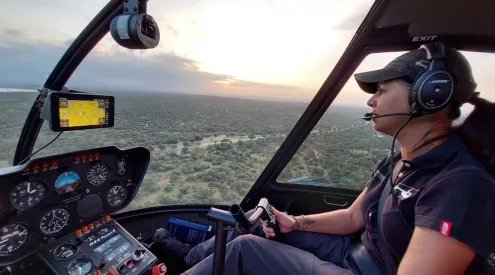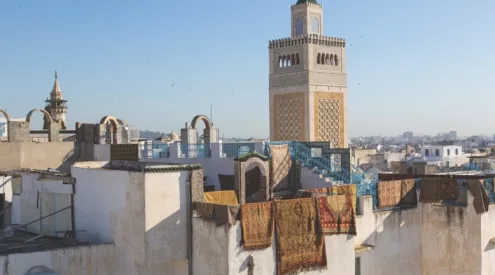You can’t go far in Lesotho without seeing people wrapped in colourful Basotho blankets, or blankets spread out on rocks and bushes to dry after rain. So when someone offers you a peek into their secret language, you don’t refuse.
’M’e ’Masetho Elizabeth Letsie is the self-appointed ambassador for the Basotho blanket, someone who first became fascinated by them as a child and now gives a ‘blanket presentation’ to anyone who visits Semonkong and shows an interest. We met her after her shift at the Semonkong Lodge and went together to her small house next to the general dealer in the village.
She starts by hauling blanket after blanket out of her cupboard, explaining what an important part of public, social and private life the Basotho blanket is, not just as an article of clothing, but as a symbol of status too. ‘The Basotho used to wear animal skins from cows, sheep or goats,’ she begins, demonstrating with a much treasured kaross that belonged to her grandmother.
But animal skins weren’t really all that warm in Lesotho’s high-altitude climate. Remember that this country has many peaks well over 3000 metres and the highest ‘lowest’ point of any country in the world (1000 metres), so it can get pretty chilly, even in mid-summer. Imagine how thrilled King Moshoeshoe must have been sometime in the 1860s when a he was presented with a warm
British blanket from Birmingham.
Originally made only for royalty, today blankets are part of everyday life for most Basotho. There are three classes, all made by Aranda in Port Elizabeth. ‘It’s difficult to tell the first two classes apart because they’re both 90% wool and 10% cotton,’ says ’M’e ’Masetho. ‘But look carefully and you’ll see the patterns are slightly different.’
’It’s true; we notice that the first class patterns are more intricate, a few more twirls and swirls that justify the slightly higher price tag (about R650 to R700, depending on the cost of wool in the year it’s made, whereas second class blankets are R400 to R450). Third class is the cheapest blanket and is 100% acrylic, costing as little as R150 to R200.
As ’M’e ’Masetho talks you learn just how practical the blankets are, keeping your body at an even temperature except when it’s really hot (although the Basotho seem to wear them in all weather). You’ll see fewer of them in everyday life near Maseru, where people are more westernised, but you can be sure they will come out for high days and holidays.
Many of the patterns are based on daily life, such as the maize cob or wheat patterns, which symbolise fertility and prosperity. My favourite is the heart pattern. The royal pattern is of crowns, like the 90-year-old example she shows us with ‘Victoria England’ on the label. Even today, all new patterns must be approved by Lesotho’s royal family.
’M’e ’Masetho still has the first blanket her husband bought her, as well as a pretty pink-and-blue one her mother gave her 18 years ago to celebrate the birth of her first son. They’re cared for with love and still look brand new. ‘You must never use soap powder on a blanket,’ she insists.
In case you think you’re clever once you can pick out a maize cob pattern and differentiate between first and second class, you come back to earth with a bump when you hear that how a blanket is worn can tell people a lot about you. Men and women wear the blanket differently. Is a father going to arrange a marriage for his child? You can tell by the way he’s wearing his blanket. You
can even tell if a woman is married or not, or if she’s had a child.
‘You need a new blanket for all celebrations like marriage and babies, and there’s a different kind of blanket for initiation too,’ she explains. Not surprisingly, boys wear blankets differently before and after circumcision. Even when you die, you’re buried with a blanket to keep you warm.
To find out more, ask at Semonkong Lodge. You’ll be drawn in by ’M’e ’Masetho’s love and understanding of these Basotho icons. You might even look at people a little differently.
Semonkong Lodge
Tel/fax +266-2700-6037, www.placeofsmoke.co.ls/
















